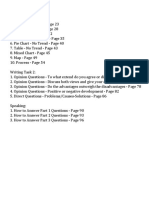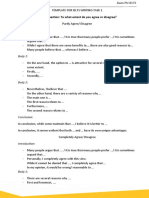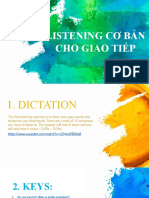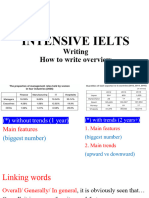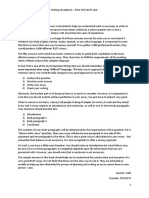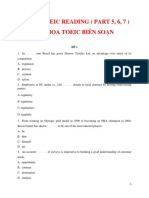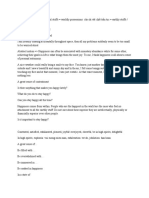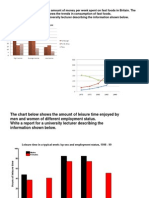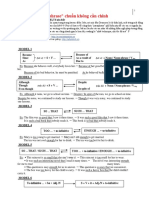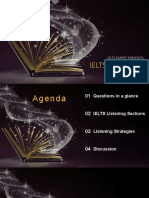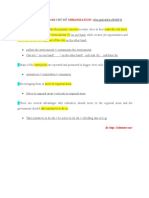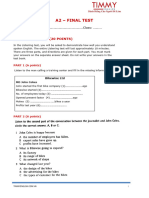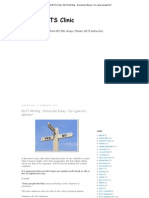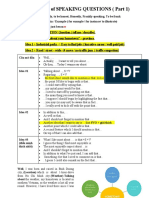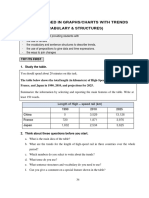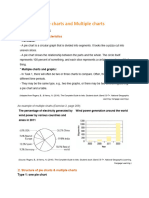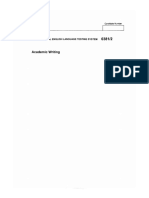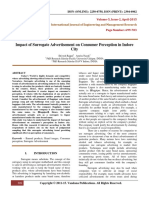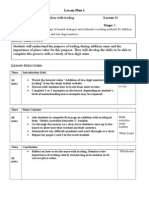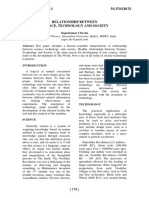0 ratings0% found this document useful (0 votes)
129 viewsIelts Readinf
Ielts Readinf
Uploaded by
Ahmad HassanThe document provides information about the format and content of the IELTS exam. It can be summarized as follows:
The IELTS exam consists of four modules - Listening, Reading, Writing, and Speaking - testing a variety of English language skills over a total test time of around 3 hours. The Reading module contains 3 passages and 40 questions to be completed within 60 minutes. Questions cover topics such as short answers, multiple choice, sentence completion and true/false. The document provides tips for preparing for and taking the Reading portion of the IELTS exam.
Copyright:
© All Rights Reserved
Available Formats
Download as PPT, PDF, TXT or read online from Scribd
Ielts Readinf
Ielts Readinf
Uploaded by
Ahmad Hassan0 ratings0% found this document useful (0 votes)
129 views25 pagesThe document provides information about the format and content of the IELTS exam. It can be summarized as follows:
The IELTS exam consists of four modules - Listening, Reading, Writing, and Speaking - testing a variety of English language skills over a total test time of around 3 hours. The Reading module contains 3 passages and 40 questions to be completed within 60 minutes. Questions cover topics such as short answers, multiple choice, sentence completion and true/false. The document provides tips for preparing for and taking the Reading portion of the IELTS exam.
Original Description:
IELTS Reading
Original Title
ielts_readinf
Copyright
© © All Rights Reserved
Available Formats
PPT, PDF, TXT or read online from Scribd
Share this document
Did you find this document useful?
Is this content inappropriate?
The document provides information about the format and content of the IELTS exam. It can be summarized as follows:
The IELTS exam consists of four modules - Listening, Reading, Writing, and Speaking - testing a variety of English language skills over a total test time of around 3 hours. The Reading module contains 3 passages and 40 questions to be completed within 60 minutes. Questions cover topics such as short answers, multiple choice, sentence completion and true/false. The document provides tips for preparing for and taking the Reading portion of the IELTS exam.
Copyright:
© All Rights Reserved
Available Formats
Download as PPT, PDF, TXT or read online from Scribd
Download as ppt, pdf, or txt
0 ratings0% found this document useful (0 votes)
129 views25 pagesIelts Readinf
Ielts Readinf
Uploaded by
Ahmad HassanThe document provides information about the format and content of the IELTS exam. It can be summarized as follows:
The IELTS exam consists of four modules - Listening, Reading, Writing, and Speaking - testing a variety of English language skills over a total test time of around 3 hours. The Reading module contains 3 passages and 40 questions to be completed within 60 minutes. Questions cover topics such as short answers, multiple choice, sentence completion and true/false. The document provides tips for preparing for and taking the Reading portion of the IELTS exam.
Copyright:
© All Rights Reserved
Available Formats
Download as PPT, PDF, TXT or read online from Scribd
Download as ppt, pdf, or txt
You are on page 1of 25
What can I expect?
How can I succeed?
www.onlineetutor.com
IELTS Exam
Listening
30 minutes, 4 sections, 40 items
(+ 10 minutes transfer time)
Academic Reading General Training Reading
60 minutes, 3 sections, 40 items 60 minutes, 3 sections, 40 items
Academic Writing General Training Writing
60 minutes, 2 tasks (150 & 250 words) 60 minutes, 2 tasks
Speaking
11 - 14 minutes, 3 parts
Total Test Time=
About 2 hours, 54 minutes
(including the 10 minute listening transfer time)
IELTS Reading Module
60 minutes
40 questions
3 reading passages
2150 – 2750 words total
Progressively becomes more difficult
Authentic readings from books (A, G), newspapers
(A, G), magazines (A, G), journals (A),
advertisements (G), notices (G), company
handbooks (G) and official documents (G)
General vs. Academic
One longer text, which is At least 1 passage will
descriptive rather than contain a detailed, logical
argumentative argument
Type of material needed on Texts are appropriate to
a daily basis in an English candidates entering
speaking country undergraduate or
Topics are relevant to postgraduate courses
everyday life in an English- Topics are on academic
speaking country topics of general interest
Short factual texts related (Ex: The coral reefs, drug
to a topic, such as hotel addiction)
advertisements and work-
related issues
Skills Assessed
A wide range of reading skills is assessed,
including: reading for gist, reading for main
ideas, reading for detail; understanding
inferences and implied meaning; recognising
a writer’s opinions, attitudes and purpose; and
following the development of an argument.*
Question Types
Short answer questions
Multiple-choice questions
Completion of sentences, notes, summaries,
tables, diagrams or flow charts
Matching headings to paragraphs or sections
of the passage
Locating information in a paragraph or
section
Matching lists/phrases
True/False/Not Given: identifying
information in the passage
Yes/No/Not Given: identifying the writer’s
view or opinion
Short Answer Questions
Questions 8 – 10
Answer the questions below using NO MORE THAN THREE
WORDS AND/OR A NUMBER for each answer.
8. Which American company is doing research on the genetic basis of hair
and eye colour?
9. How many groups of eye colour can now be identified through SNP
mapping?
10. Which British institution unsuccessfully researched data from humans
on the genetic basis of facial features?
Multiple-Choice Questions
Completion Questions
Completion of sentences, notes, summaries, tables, diagrams or flow charts
The words you use to answer the question
must be taken directly from the text; DO
NOT paraphrase the answer or put it in your
own words or you will not get the answer
correct
Table Completion Example
Completion Questions
Diagram Label Completion Example
Matching Headings Questions
Matching headings to paragraphs or sections of the passage
Locating Info Questions
Matching Lists/Phrases
True/False/NG Questions
Questions 1 – 4
Do the following statements agree with the information given in Text 1?
Write
TRUE if the statement agrees with the information
FALSE if the statement contradicts the information
NOT GIVEN if there is no information on this
1. Just over one third of the total population of the US is overweight.
2. Asia and Europe have an equal proportion of obese children.
3. It is forecast that the proportion of overweight or obese children in China
will reach 20% in ten years’ time.
4. There is a downward trend in childhood obesity in some African towns and
cities.
Yes/No/Not Given Questions
Scoring
Each correct
answer receives
1 mark
(You can’t get partial
credit so watch your
spelling and
grammar)
From 2006
Tips – Before Taking the Test
Build your vocabulary and synonym word bank
Keep a notebook of unknown words and make
vocabulary cards
Practice skimming and scanning
Improve your spelling and grammar
Misspelled words will be marked incorrect
Grammar knowledge is important
Helps you guess the type of word for sentence completion
tasks (ex: n, v, adj, plural n)
Know word forms (n – v- adj/ Ex: impression – impress –
impressionable)
Tips – Before Taking the Test
Learn organizing words (for matching tasks) such as:
advantage, aim, analysis, benefit, consequence, difference,
difficulty, discrepancy, effect, factor, feature, goal, hazard,
influence, objective, outcome, outline, problem, purpose,
reason, risk, role, strategy
Understand qualifying words (often for multiple
choice questions) such as: mainly, usually, the majority,
the most
Tips – Before Taking the Test
Know prefixes (un-, pre-) and suffixes (-ful, -less)
Read from a variety of sources
Do practice tests
Practice analyzing questions
Work on understanding meaning to increase your speed
When you’ve become more comfortable with the
reading test, give yourself timed practice
Tips – During the Test
1. Read the directions
2. Look at the title and headings of the passage to get
an idea of what it’s about
You can also read the 1st sentence of the 1st paragraph
3. Look at the questions
Underline or circle key words in the question
Think of possible answers
4. Scan the passage for key words and synonyms
Tips – During the Test (cont.)
5. When you find the paragraph/area where the word
is, circle or underline the word and skim that area
Is this the correct area? Can you find the answer here?
If not, then you need to search the text again.
6. If you have more than 1 answer, mark the possible
answers on your test booklet (not answer sheet) and
then go back after completing that section
Tips – During the Test (cont.)
7. For matching headings questions:
Skim the headings
Find key words or organizing words like problem, effects,
reason, etc. and circle or underline them
Scan the text for key words or organizing words
Think of the logical order
8. Predict which paragraph each heading relates to
9. Quickly read the paragraphs
If you have 2 possibilities, write the letters next to it
and go back to it after you have matched all headings
Tips – During the Test (cont.)
Keep in mind, sometimes the questions follow the
order of information
When you answer the questions, don't spend too much
time on the ones you don't feel sure about. Make a
guess and go on.
Remember that you’re not reading the texts for
enjoyment; you need to quickly find the answer
Tips – During the Test (cont.)
After you have answered all the questions, you can go
back and check the ones you aren't sure about (if you
have time left)
Write your answers directly onto your answer sheet
• Don't spend more than 20 minutes on each passage
You have about 1 ½ minutes to answer each question
You might also like
- Martial Arts - 72 Shaolin Skills Dim MakDocument49 pagesMartial Arts - 72 Shaolin Skills Dim Makmugilan93% (61)
- IELTS Vocabulary-EDUCATIONDocument8 pagesIELTS Vocabulary-EDUCATIONLan HoàngNo ratings yet
- The Slovin FormulaDocument3 pagesThe Slovin FormulaOdie Valdez80% (10)
- Ielts Handbook - Theory PDFDocument102 pagesIelts Handbook - Theory PDFBao TranNo ratings yet
- How To Write-Ielts Task 1Document35 pagesHow To Write-Ielts Task 1Zorana IgnjatovicNo ratings yet
- Ielts Writing Task 1 ProcessDocument24 pagesIelts Writing Task 1 ProcessNam NGUYENNo ratings yet
- Ielts SPK PracticeDocument29 pagesIelts SPK PracticeShayne DomingoNo ratings yet
- Idioms Ebook - DR - Christina NguyenDocument109 pagesIdioms Ebook - DR - Christina Nguyen王玉No ratings yet
- IELTS Speaking With MysheoDocument18 pagesIELTS Speaking With MysheoKritee KriteeNo ratings yet
- IELTS 5 Kinds of Writing Task 2Document42 pagesIELTS 5 Kinds of Writing Task 2Đức PhúNo ratings yet
- Idioms from Lớp Ngọng thầy VũDocument12 pagesIdioms from Lớp Ngọng thầy VũLê Huyền LinhNo ratings yet
- Question: To What Extent Do You Agree or Disagree?Document5 pagesQuestion: To What Extent Do You Agree or Disagree?Khánh NgânNo ratings yet
- IELTS Writing Task 2 - Environmental ProblemsDocument3 pagesIELTS Writing Task 2 - Environmental ProblemsJHolicNo ratings yet
- Listening Cơ Bản Cho Giao TiếpDocument36 pagesListening Cơ Bản Cho Giao TiếpXuân QuỳnhNo ratings yet
- Open Day Presentation - Part 3 SpeakingDocument31 pagesOpen Day Presentation - Part 3 SpeakingSaigon EnglishNo ratings yet
- Thieu Nang - Module III (Full)Document181 pagesThieu Nang - Module III (Full)Đào Huỳnh Phúc100% (1)
- Overview Writing Task 1Document21 pagesOverview Writing Task 1Robin QuânNo ratings yet
- 50 Sample Answers For IELTS WritingDocument53 pages50 Sample Answers For IELTS WritingNovák ÉvaNo ratings yet
- ĐỀ TOEIC READING - TỪ MS HOA TOEICDocument29 pagesĐỀ TOEIC READING - TỪ MS HOA TOEICPhuoc PhanNo ratings yet
- A - Book - Writing Level 3. Eng 217 - Oct 2022 - Send SsDocument74 pagesA - Book - Writing Level 3. Eng 217 - Oct 2022 - Send SsNguyễn Thuý VyNo ratings yet
- Ielts Speaking CollectionDocument17 pagesIelts Speaking CollectionThanh NguyenNo ratings yet
- Structure of IELTS Writing Task 1 Table - STDocument10 pagesStructure of IELTS Writing Task 1 Table - STnga lụcNo ratings yet
- Ielts WritingDocument7 pagesIelts WritingMigle SkucaiteNo ratings yet
- Giao Trinh Writing Level 3Document72 pagesGiao Trinh Writing Level 3Trịnh Bảo MinhNo ratings yet
- 40 cấu trúc ngữ pháp - IELTS Tố Linh PDFDocument7 pages40 cấu trúc ngữ pháp - IELTS Tố Linh PDFWei TurtleNo ratings yet
- Ielts 6.5 - WritingDocument12 pagesIelts 6.5 - WritingĐàm Quang Thanh TúNo ratings yet
- IELTS Listening - StrategyDocument23 pagesIELTS Listening - StrategyilmiNo ratings yet
- Bộ Đề Kiểm Tra Tiếng Anh 8 Smart World Đủ File Nghe Đáp Án Unit 2Document7 pagesBộ Đề Kiểm Tra Tiếng Anh 8 Smart World Đủ File Nghe Đáp Án Unit 2QuaNo ratings yet
- Xuân Phi Ielts - Ielts Task 1 Actual Test 28-11-2020Document3 pagesXuân Phi Ielts - Ielts Task 1 Actual Test 28-11-2020billbill92No ratings yet
- All of Ielts Writing Models in Task 1Document28 pagesAll of Ielts Writing Models in Task 1Bui Phuong AnhNo ratings yet
- Basic For Ielts Course Book PDFDocument80 pagesBasic For Ielts Course Book PDFHiệu Nguyễn CôngNo ratings yet
- Test 5 Ban DepDocument6 pagesTest 5 Ban Depletrantu2dthNo ratings yet
- Đọc Viết 2 - 23092021Document9 pagesĐọc Viết 2 - 23092021Phương LanNo ratings yet
- Writing Task 1-2022-Chia Sẻ Tài Liệu Học IELTS 9.0Document205 pagesWriting Task 1-2022-Chia Sẻ Tài Liệu Học IELTS 9.0Vũ Thái SơnNo ratings yet
- (HTTP://WWW - Ieltstutor.me/) - IELTS Vocabulary - Band 8.0 - Topic - UrbanizationDocument6 pages(HTTP://WWW - Ieltstutor.me/) - IELTS Vocabulary - Band 8.0 - Topic - UrbanizationTUTOR IELTS100% (2)
- Listening VSTEP B1Document16 pagesListening VSTEP B1phuongthaospkNo ratings yet
- 1644910852ielts Writing Task 1 - AcademicDocument55 pages1644910852ielts Writing Task 1 - AcademicBurcu BaydemirNo ratings yet
- 10 Đề Thi Reading Thật - IELTS FighterDocument55 pages10 Đề Thi Reading Thật - IELTS FighterLý Thảo UyênNo ratings yet
- A2 Final Written TestDocument5 pagesA2 Final Written TestLan NguyenNo ratings yet
- Ielts Foundation Progress TestDocument10 pagesIelts Foundation Progress TestPhạm NgânNo ratings yet
- Phuket IELTS Clinic - IELTS Writing - Discussion Essay - Do I Give My OpinionDocument3 pagesPhuket IELTS Clinic - IELTS Writing - Discussion Essay - Do I Give My OpinionamritjosanNo ratings yet
- T NG H P B NG Keyword Table Cho Ielts Listening by NgocbachDocument4 pagesT NG H P B NG Keyword Table Cho Ielts Listening by Ngocbachle khac hungNo ratings yet
- Đề Writing IELTS 2013 - 2018 PDFDocument52 pagesĐề Writing IELTS 2013 - 2018 PDFngoctrucleNo ratings yet
- 7 Types of Speaking Questions (Part 1) : Se SeDocument10 pages7 Types of Speaking Questions (Part 1) : Se SeMỹ Đặng100% (1)
- Report Writing Term 1 2021-2022 - Unit 3Document19 pagesReport Writing Term 1 2021-2022 - Unit 3linhNo ratings yet
- Cập nhật Đề Thi Speaking quý 2 (tháng 5 - tháng 8) năm 2021Document36 pagesCập nhật Đề Thi Speaking quý 2 (tháng 5 - tháng 8) năm 2021Minh Anh LeNo ratings yet
- Writing Task 2: Cause-Problem - Solution: Sample EssayDocument4 pagesWriting Task 2: Cause-Problem - Solution: Sample EssayTu Nguyen Thi CamNo ratings yet
- 021Z - IELTS Writing Task 1 - Lesson 9Document22 pages021Z - IELTS Writing Task 1 - Lesson 920 03 10 Nhật HàoNo ratings yet
- 01 Skimming and Sentence CompletionDocument4 pages01 Skimming and Sentence CompletionSOtgonborNo ratings yet
- English Collocation in Use - CambridgeDocument137 pagesEnglish Collocation in Use - CambridgeTú NguyễnNo ratings yet
- Teaching ReadingDocument74 pagesTeaching ReadingOğuzhan DalkılıçNo ratings yet
- Unit 1 IELTS Writing模板Document55 pagesUnit 1 IELTS Writing模板Yifan DingNo ratings yet
- Writing - Unit 1 - IntroductionDocument6 pagesWriting - Unit 1 - IntroductionMeggie NguyenNo ratings yet
- Ultimate IELTS ListeningDocument57 pagesUltimate IELTS ListeningsushikumNo ratings yet
- L17. Writing 6 - Task 1 - Pie Charts Multiple Charts - Before ClassDocument13 pagesL17. Writing 6 - Task 1 - Pie Charts Multiple Charts - Before ClassLinh Vy HàNo ratings yet
- Nâng Cấp Writing Task 1 Dynamic ChartDocument2 pagesNâng Cấp Writing Task 1 Dynamic ChartThảo PhươngNo ratings yet
- Master IELTS Visuals Writing Task 2 Maps EBRAHIM TAHASSONIDocument8 pagesMaster IELTS Visuals Writing Task 2 Maps EBRAHIM TAHASSONIWilliams AlvaradoNo ratings yet
- Covered A Lot of Ground: To Go Through Pregnancy Later in LifeDocument15 pagesCovered A Lot of Ground: To Go Through Pregnancy Later in LifeTRONG DANG QUANGNo ratings yet
- Speaking Part 1 Ielts FreeDocument42 pagesSpeaking Part 1 Ielts FreeThu VânnNo ratings yet
- De Thi That IELTS Speaking 2023Document133 pagesDe Thi That IELTS Speaking 2023Tien AuNo ratings yet
- What Can I Expect? How Can I Succeed?Document25 pagesWhat Can I Expect? How Can I Succeed?Nguyễn HàNo ratings yet
- Oet Reading 1 (A&b)Document66 pagesOet Reading 1 (A&b)Richard James San Jose100% (1)
- Advanced Performance Management IIDocument33 pagesAdvanced Performance Management IIAhmad HassanNo ratings yet
- Business PlanDocument6 pagesBusiness PlanAhmad HassanNo ratings yet
- GOCLEAN Brochure-3.0Document19 pagesGOCLEAN Brochure-3.0Ahmad HassanNo ratings yet
- CPD MOneyDocument25 pagesCPD MOneyAhmad HassanNo ratings yet
- FriendshipDocument67 pagesFriendshipAhmad HassanNo ratings yet
- Human Resource Department: Subject: General PolicyDocument19 pagesHuman Resource Department: Subject: General PolicyAhmad HassanNo ratings yet
- Ac WritingDocument3 pagesAc WritingAhmad HassanNo ratings yet
- Business Communication: by Dr. Amna BatoolDocument17 pagesBusiness Communication: by Dr. Amna BatoolAhmad HassanNo ratings yet
- Business Communication - 2Document11 pagesBusiness Communication - 2Ahmad HassanNo ratings yet
- Bonanza Blast PPT World enDocument13 pagesBonanza Blast PPT World enAhmad HassanNo ratings yet
- Baal BerithDocument3 pagesBaal BerithEmry Kamahi Tahatai KereruNo ratings yet
- Answers TallyDocument2 pagesAnswers TallyRonna Mae DungogNo ratings yet
- Mental State Examination-PabustanDocument4 pagesMental State Examination-PabustanJc Pauline PabustanNo ratings yet
- The Doctrine of Ahla'l-Sunna Vs The Salafist Movement (English)Document63 pagesThe Doctrine of Ahla'l-Sunna Vs The Salafist Movement (English)Dar Haqq (Ahl'al-Sunnah Wa'l-Jama'ah)100% (2)
- Notes - Bordo, S. (1993) Feminism, Foucault and The Politics of The BodyDocument2 pagesNotes - Bordo, S. (1993) Feminism, Foucault and The Politics of The BodySimon FialaNo ratings yet
- Ferl Diane S. Siño BSA15Document2 pagesFerl Diane S. Siño BSA15Ferl Diane SiñoNo ratings yet
- ImpactOfSurrogateAdvertisementOnConsumerPerceptionInIndoreCity (699 703)Document5 pagesImpactOfSurrogateAdvertisementOnConsumerPerceptionInIndoreCity (699 703)samy sharmaNo ratings yet
- Math Lesson SequenceDocument8 pagesMath Lesson Sequenceapi-238885563No ratings yet
- Class Work Let 1 - 4 - U3c1l5 - Pathway To SuccessDocument2 pagesClass Work Let 1 - 4 - U3c1l5 - Pathway To Successapi-504417153100% (1)
- The Four Resource Model PDFDocument1 pageThe Four Resource Model PDFRogério TilioNo ratings yet
- Theory and Research in Developmental PsychologyDocument26 pagesTheory and Research in Developmental PsychologycmescondeNo ratings yet
- English 7Document18 pagesEnglish 7Mai SasaNo ratings yet
- Fuzzy Differential Evolution AlgorithmDocument118 pagesFuzzy Differential Evolution AlgorithmSakthivelan RamachandranNo ratings yet
- Conspiracy Theories Causes and CuresDocument26 pagesConspiracy Theories Causes and CuresMano Ratyi100% (2)
- God RemainsDocument18 pagesGod RemainsalexielNo ratings yet
- Human Resource ManagementpptDocument59 pagesHuman Resource ManagementpptPrasandth ShankarNo ratings yet
- Sangeeta Reiki Healing 2501Document30 pagesSangeeta Reiki Healing 2501snageetaorryNo ratings yet
- Venus Project Book ListDocument1 pageVenus Project Book ListEquariusNo ratings yet
- Romans 4 17 25 How Can I Accomplish God S Will in My LifeDocument2 pagesRomans 4 17 25 How Can I Accomplish God S Will in My LifeCabagnot Piolo JuliusNo ratings yet
- ADEC - Oasis International School 2016-2017Document19 pagesADEC - Oasis International School 2016-2017Edarabia.comNo ratings yet
- ACE-III Scoring (Australian)Document10 pagesACE-III Scoring (Australian)Livgian KaurNo ratings yet
- Relationship Between Science TechnologyDocument2 pagesRelationship Between Science TechnologyMichelle Lapiña100% (1)
- Nothing Without You - Warcraft Fanfic (Illidan - Maiev) PT 2Document7 pagesNothing Without You - Warcraft Fanfic (Illidan - Maiev) PT 2tonktanksNo ratings yet
- G Science PDFDocument177 pagesG Science PDFTaslima TabassumNo ratings yet
- Cognitive Development of Primary SchoolersDocument16 pagesCognitive Development of Primary SchoolersEva Michelle Tolentino DatoNo ratings yet
- 12th EnglishDocument4 pages12th EnglishSaahil Ledwani0% (1)
- The Disadvantages of An Elite Education PDFDocument7 pagesThe Disadvantages of An Elite Education PDFPhạm Văn TưởngNo ratings yet
- 490 (23) Shoemaker Self-ReferenceDocument4 pages490 (23) Shoemaker Self-ReferencefilsoofNo ratings yet



